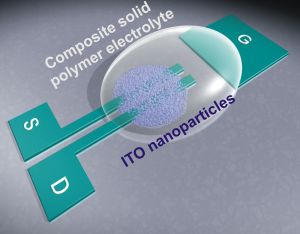Scientists of the KIT Institute of Nanotechnology (INT) have achieved major progress in printed electronics: They demonstrated that highly mobile field effect transistors (FET) can be made of printed inorganic oxide nanoparticles. These are combined with printable composite solid polymer electrolytes as an insulator of the gate electrode. The results are reported in the “Advanced Functional Materials” journal.
Work of the KIT researchers shows that the switching speed of electrochemically gated printed transistors does not depend on the conductivity of the electrolyte insulator, but on the printing resolution. If it is succeeded in printing the composite solid polymer electrolytes (CSPE) in ultra-thin layers, an extremely high switching speed can be achieved. If the electrolyte insulator is applied in layers of a few hundred nanometers in thickness, switching speed exceeds one megahertz. “This finding paves the way for electrochemically gated components in printed electronics”, explains Dr. Subho Dasgupta from the INT of KIT.
FET have three electrodes: The source of the charge carriers, the drain electrode, and the gate. The resistance and, hence, current between the drain and the source are determined by the voltage between gate and source and the resulting electric field. FET can be applied in many areas, for instance, in integrated circuits used for the labeling of products and goods. By printing, such transistors can be produced in large series at low costs.
Subho Dasgupta, Ganna Stoesser, Nina Schweikert, Ramona Hahn, Simone Dehm, Robert Kruk, Horst Hahn: Printed and Electrochemically Gated, High-Mobility, Inorganic Oxide Nanoparticle FETs and Their Suitability for High-Frequency Applications. In: Advanced Functional Materials, 20 JUL 2012; DOI: 10.1002/adfm.201200951. ©2012 WILEY-VCH Verlag GmbH & Co. KGaA, Weinheim.
Being “The Research University in the Helmholtz Association”, KIT creates and imparts knowledge for the society and the environment. It is the objective to make significant contributions to the global challenges in the fields of energy, mobility, and information. For this, about 10,000 employees cooperate in a broad range of disciplines in natural sciences, engineering sciences, economics, and the humanities and social sciences. KIT prepares its 22,800 students for responsible tasks in society, industry, and science by offering research-based study programs. Innovation efforts at KIT build a bridge between important scientific findings and their application for the benefit of society, economic prosperity, and the preservation of our natural basis of life. KIT is one of the German universities of excellence.

